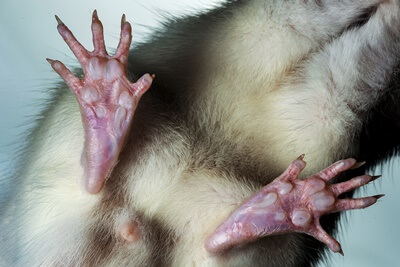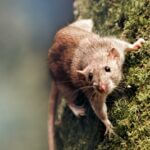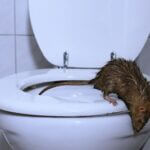Rats are opportunistic prey animals renowned for their elusiveness, agility, and flexibility. They can scale rough surfaces and pass through the tiniest spaces, primarily due to the design of their claws.
Rats use their claws for locomotion, scavenging, hunting, digging, and fighting.
Their long and sharp claws allow them to climb and grip textured surfaces. Their feet help them burrow through tiny holes to escape predators and gain entry to homes.
Rats use their claws for balance and navigation. Running across a narrow rope is easier with sharp, long claws that can dig into the fibers.
They can also gain traction on rough terrain and sprint with long claws to propel them forward. Rats have 18 claws, one for each toe, which gives them a reliable grip.
Do Rats Have Claws Or Paws?
Like most four-legged mammals, rats have feet that comprise paws and claws. They have 4 feet, which they use for various functions, ranging from movement to fighting.
Their foot anatomy consists of a pair of forefeet and hindfeet. The forefeet has 4 toes each, while the hindfeet has 5 toes. Rat claws are non-retractable since they are used often for daily activities.
The claws consist of two parts:
- Nail plate (dorsal unguis).
- Sole plate (subunguis).
The nail plate is the hard, external part of the claws. Meanwhile, the sole plate is the soft underside of the claws that forms a cushion-like pad.
According to the American Association for Anatomy, rats have paws adapted for:
- Climbing.
- Foraging for food.
- Handling prey.
Rats’ paws consist of multiple deformable pads that assist in movement. Because rats usually walk on their toes, mainly toward the front of their paws, their pads remain clustered on the anterior of the foot.
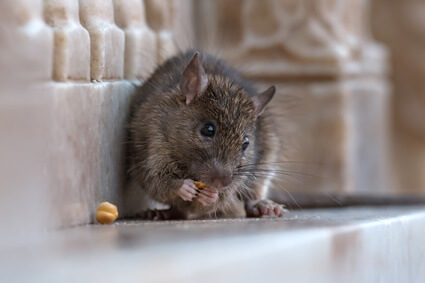
How Many Claws Does A Rat Have?
Rats have 18 claws: 8 on their front feet and 10 on their hind feet.
Each front foot has 4 toes and claws, and each back foot has 5 toes and claws.
Rats have forefeet and hindfeet, similar to other members of the order Rodentia. Their claws enable them to scale walls and sprint across roofs without falling or losing balance.
Rats have paws, which they use to reach out for food. According to Gaziantep University, rats show a preference for their right paws.
Rats’ nails continue to grow throughout their lives. However, their claws wear down naturally as rats run on various terrains and hard surfaces.
If the claws grow too long, rats may trim them by biting them to an appropriate length.
Rat Claws Functions
Rats use their claws for different purposes, from running to foraging. Their long, sharp, non-retractable claws are a survival adaptation.
Here’s how a rat uses its claws:
Running
Rats are cautious animals that spend most of their time running rather than walking. They’re fast runners, using their claws for traction when sprinting across different surfaces and terrains.
Even though rats prefer to run, they’ll walk if they feel safe in their environment. Their claws enable them to maintain balance on smooth and unstable surfaces.
Climbing
Rats are good climbers. Due to their long, sharp claws, they can scale walls, trees, and rope. They can also effortlessly climb brick and concrete walls when searching for food or escaping threats.
Burrowing
Rats dig underground pathways and tunnels to build their nests and hiding spots. They also use these holes for food storage and insulation during harsh weather.
Their burrows have one main entrance with two or more emergency exit points, and the tunnels often lead to food sources. Their sharp claws make creating burrows possible.
Swimming
Rats can swim a mile without stopping and wade in the water for 3 days without drowning.
Rats use their claws and paws for swimming in open water, sewers, and plumbing traps. The extra drag created by claws propels rats forward and helps them tread water.
Scavenging
According to Applied Animal Behavior Science, rats are natural scavengers.
Rats use their claws to forage for food in:
- Abandoned holes.
- Beehives.
- Trash bins.
- Compost pits.
- Feed stores.
- Chicken coops.
Sometimes, rats may have to scale trees when searching for fruits, bird eggs, and young chicks to devour. This is where their long, sharp claws come in handy.
Hunting
Rats aren’t active hunters. Most prefer to scavenge on leftover food in homes and the wild.
However, that doesn’t mean rats can’t hunt for food. When little food is available, rats usually go hunting to compensate for their food sources running out.
Although rats are usually the prey of other animals, they also prey on lizards, birds, fish, small snakes, and insects. They use their claws to grip their prey and tear it apart.
Fighting
Rats are territorial animals that live in colonies.
They act aggressively toward strange rats and will fight to protect their family. Even in the same family, rats fight each other over food, using their claws to gain supremacy.
Whoever has the sharpest, strongest, and longest claws will have a distinct advantage in a grabbing-and-slashing match. Rats’ claws are also beneficial for self-defense against larger predatory animals.
Do Rats Have Sharp Claws?
Rats have long, sharp claws, essential for navigating various terrains.
Rats couldn’t scale walls, trees, and other exterior surfaces without them. Their claws are vital for gripping different surfaces, ensuring optimal movement and balance.
Aside from movement, rats also need sharp claws to forage and grasp their food. Even though rats aren’t active hunters and prefer to be scavengers, they hunt when food sources run out.
Rats’ sharp claws are helpful when hunting:
- Insects.
- Lizards.
- Chicks.
Since rats dig holes for hiding and nesting, they require sharp claws to create burrows and tunnels. They also use their strong legs to broaden narrow cracks, making passing through tight spaces easier.
Do Rats Have Long Claws?
Rats have long claws that grow throughout their lives, and their claws naturally reach these lengths as a structural and survival adaptation.
They use their claws for different purposes, including;
- Digging.
- Foraging.
- Climbing trees.
- Grooming.
- Self-defense.
Rats prefer to scavenge for food at night when no one is watching. They like being out of sight and only come out during the day when starving and have no other option.
Long claws increase traction, allowing them to run to food sources and back to their hiding spots.
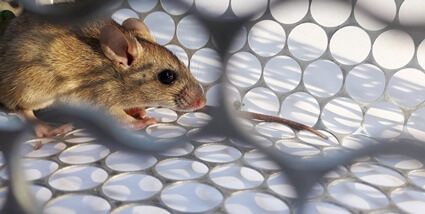
Do Rats Have Retractable Claws?
Rats’ claws are non-retractable since they use them regularly to climb, forage, and gain traction. They’re often a target for predators, so they must be ready to run and scale surfaces at any moment.
How Do Rats Trim Their Claws?
Rats’ claws continue growing throughout their lives, but keep them at a reasonable length.
Rats run around on hard surfaces to wear down the nails. They also trim their nails by biting the ends with their strong teeth.
If rats didn’t maintain their nails, they would grow into their paws and cause discomfort. With teeth harder than humans, rats have no problem biting through their claws when necessary.
Are Scratches from Rats’ Claws Dangerous?
A scratch from a rat is dangerous, as they carry numerous diseases they transmit to humans through bites and scratches. Also, rats’ saliva can contain bacteria, viruses, and other deadly pathogens.
Diseases transmitted by rats to humans include:
- Salmonella.
- Leptospirosis.
- Tularemia.
- Hantavirus.
- Rat-bite fever.
- Bubonic plague.
- Lymphocytic choriomeningitis.
According to the American Society for Microbiology, diseases spread through bites, such as rat-bite fever. Scratches from a rat’s sharp claws can also pass them on to humans.
Rats primarily use their claws for balance, running, and climbing surfaces. They also use their claws to explore, forage, and dig burrows more effectively.

